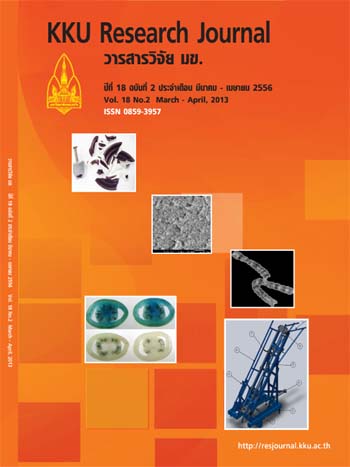Pennywort drying using infrared radiation: drying kinetics, energy consumption and quality aspect
Main Article Content
Abstract
The objectives of this research were to feasibility study of Pennywort drying for producing herbal tea and to develop of mathematical model for prediction drying kinetics of pennywort dried with infrared (IR) radiation and finally, the sensory evaluation and energy consumption were determined. The IR drying experiments were carried out at drying temperatures of 50-70 ๐ C and infrared powers of 500-1,500 W while the reference pennywort sample was dried by solar drying. To study of drying kinetic of pennywort, the initial moisture content of fresh pennywort sample was about of 600% dry-basis until the ?nal moisture content of sample reached to 60% dry-basis. The experimental results showed that the simulated data using the Midilli et al’ model was the best fitting to experimental data for all drying conditions. To determine effect of drying strategies on drying kinetics and quality of pennywort, the conclusion stated that infrared power and drying temperature relatively affected to drying pennywort such as drying kinetics, drying time, quality and specific energy consumption. The results showed that IR drying with power of 1,500 W and drying temperature of 70 ๐ C had low drying time (30 min) correlated to low specific energy consumption (0.31 MJ/kg of water evaporated). Additionally, the sensory evaluation results showed that drying temperatures and infrared power values in each drying conditions significantly affected to color, aroma, flavor and visual appearance (p<0.05). However, pennywort drying with infrared radiation for all drying conditions had no significant effect to overall sensory acceptability (p>0.05).
Article Details
How to Cite
Tirawanichakul, S., Chanchiew, S., & Tirawanichakul, Y. (2017). Pennywort drying using infrared radiation: drying kinetics, energy consumption and quality aspect. Asia-Pacific Journal of Science and Technology, 18(2), 311–324. retrieved from https://so01.tci-thaijo.org/index.php/APST/article/view/82850
Section
Research Articles

